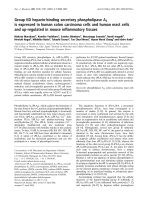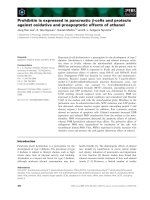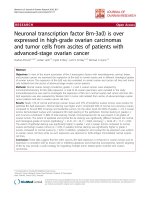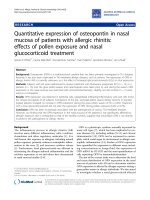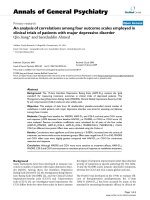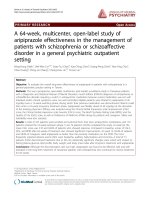ADAM10 is expressed in human podocytes and found in urinary vesicles of patients with glomerular kidney diseases pptx
Bạn đang xem bản rút gọn của tài liệu. Xem và tải ngay bản đầy đủ của tài liệu tại đây (896 KB, 9 trang )
Gutwein et al. Journal of Biomedical Science 2010, 17:3
/>The cost of publication in Journal of Biomedical Science
is bourne by the National Science Council, Taiwan.
Open Access
RESEARCH
© 2010 Gutwein et al; licensee BioMed Central Ltd. This is an Open Access article distributed under the terms of the Creative Commons
Attribution License ( which permits unrestricted use, distribution, and reproduction in
any medium, provided the original work is properly cited.
Research
ADAM10 is expressed in human podocytes and
found in urinary vesicles of patients with
glomerular kidney diseases
Paul Gutwein*
1
, Anja Schramme
2
, Mohamed Sadek Abdel-Bakky
1
, Kai Doberstein
1
, Ingeborg A Hauser
3
,
Andreas Ludwig
4
, Peter Altevogt
5
, Stefan Gauer
3
, Anja Hillmann
6
, Thomas Weide
6
, Christine Jespersen
1
,
Wolfgang Eberhardt
1
and Josef Pfeilschifter
1
Abstract
Background: The importance of the Notch signaling in the development of glomerular diseases has been recently
described. Therefore we analyzed in podocytes the expression and activity of ADAM10, one important component of
the Notch signaling complex.
Methods: By Western blot, immunofluorescence and immunohistochemistry analysis we characterized the expression
of ADAM10 in human podocytes, human urine and human renal tissue.
Results: We present evidence, that differentiated human podocytes possessed increased amounts of mature ADAM10
and released elevated levels of L1 adhesion molecule, one well known substrate of ADAM10. By using specific siRNA
and metalloproteinase inhibitors we demonstrate that ADAM10 is involved in the cleavage of L1 in human podocytes.
Injury of podocytes enhanced the ADAM10 mediated cleavage of L1. In addition, we detected ADAM10 in urinary
podocytes from patients with kidney diseases and in tissue sections of normal human kidney. Finally, we found
elevated levels of ADAM10 in urinary vesicles of patients with glomerular kidney diseases.
Conclusions: The activity of ADAM10 in human podocytes may play an important role in the development of
glomerular kidney diseases.
Background
The important role of podocytes in the development of
many glomerular diseases are documented in renal disor-
ders like minimal change disease, focal segmental glomeru-
losclerosis and membranous nephropathy [1]. Adhesion
molecules like the integrin α
3
β
1
and dystroglycan are the
major receptors studied today, which connect the podocytes
to the glomerular basement membrane (GBM) [2]. During
development L1 adhesion molecule is known to be regu-
lated in the renal epithelium and is involved in kidney
branching morphogenesis [3]. L1 adhesion molecule exists
in a transmembrane form, but can also be processed into a
soluble form about 200 kDa by a disintegrin and metallo-
proteinase (ADAM10) [4,5]. Furthermore, L1 adhesion
molecule can be cleaved in vitro in the third fibronectin III
domain by trypsin [6], plasmin [7] or the proprotein con-
vertase PC5A [8], resulting in a 140 kDa and 80 kDa frag-
ment. Interestingly, different patterns of proteolytic
cleavage of L1 during nephrogenesis have been observed,
but the significance of this cleavage remains unclear [3]. In
addition, a 200 kDa soluble form of L1 adhesion molecule
was found in patients with acute tubular necrosis and may
represent a marker of distal nephron injury [9]. In the devel-
oping rat kidney ADAM10 was highly expressed in the late
ureteric bud [10]. Recently we have characterized in detail
the tubular and glomerular ADAM10 expression in the
human kidney [11,12]. Interestingly, we found in renal
allograft biopsies with histopathological diagnosis of acute
interstitial rejection increased tubular ADAM10 expression,
which was accompanied by high numbers of infiltrating T-
cells [12]. It is known, that ADAM10 is involved in the
cleavage of growth factors, adhesion molecules and cell
* Correspondence:
1
Pharmazentrum frankfurt/ZAFES, University Hospital Goethe University
Frankfurt, Frankfurt am Main, Germany
Gutwein et al. Journal of Biomedical Science 2010, 17:3
/>Page 2 of 9
surface receptors like Notch and their ligands Delta and
Jagged [13]. In this context, two recent publications have
highlighted the importance of the Notch signaling pathway
in podocytes for the development of glomerular diseases.
Waters et al reported, that ectotopic Notch activation in
developing podocytes leads to glomerulosclerosis [14]. In
addition, increased expression of the intracellular domain
of Notch-1 was found in podocytes of patients with diabetic
nephropathy and focal segmental glomerulosclerosis [15].
To characterize the expression of ADAM10 and its sub-
strates L1 adhesion molecule in more detail, we analyzed
their expression in a human podocyte cell line and in human
renal tissue. We demonstrate that ADAM10 and L1 are
expressed in human podocytes. In differentiated podocytes
we detected increased amounts of mature ADAM10 and
high levels of soluble L1. In addition, injuring podocytes
with puromycin induced ADAM10 mediated cleavage of
L1. Furthermore podocytes isolated from urines of patients
with glomerular kidney diseases expressed constitutively
ADAM10. Isolating urinary vesicles from healthy donors
and patients with inflammatory kidney diseases, revealed
increased amounts of ADAM10 expression in patients with
glomerular kidney diseases.
Methods
Chemicals
Interferon-γ (IFN-γ) was purchased from Peprotech (Frank-
furt, Germany), hyperfilms and the enhanced chemilumi-
nescence (ECL) reagents were ordered from Amersham
Pharmacia Biotech Europe GMBH (Freiburg, Germany),
all cell culture nutrients were from Invitrogen/Life Technol-
ogies (Karlsruhe, Germany). The ADAM10 specific inhibi-
tor GI254023X was assayed for inhibition of recombinant
human ADAM17 and ADAM10 ectodomains as described
before [16].
Cell Culture
Human condititionally immortalized podocytes (HPC) were
isolated and cultivated as previously described [17]. Prior
to stimulation, cells were incubated for 16 h in RPMI 1640
medium, supplemented with 0.1 mg/ml of fatty acid-free
bovine serum albumine.
Experimental subjects
We examined the urines of a group of 7 individuals com-
posed of 5 patients with glomerular diseases (diagnosis of
patients are depicted in Table 1) and 2 healthy subjects.
Isolation of cells from human urines
Freshly voided urine of healthy donors and patients with
glomerular kidney diseases were centrifuged at room tem-
perature at 700 g for 10 min. The supernatant was removed
by careful aspiration, the cell pellet was resuspended in 10
ml podocyte medium. The cell suspension was placed into
culture flasks and incubated at 37°C in 5% CO
2
.
Antibodies
Mouse mAb (L1-11A) to the ectodomain of human L1
adhesion molecule and polyclonal L1 were provided from
Prof. Dr. Altevogt (Heidelberg, Germany). Monoclonal
antibody to the extracellular part of ADAM10 was from
R&D Systems (Wiesbaden-Nordenstadt, Germany). Poly-
clonal anti-ADAM10 antibody from eBioscience (San
Diego, USA) was used for Western blot and immunofluo-
rescence staining. Polyclonal antibodies against nephrin
and podocin were kindly provided from Dr. Shuyu Ren
(Bern, Switzerland). Monoclonal antibodies for β1 and α3
integrin subunits were from Chemicon (Hampshire, United
Kingdom, England). WT1 antibody for immunofluores-
cence analysis was purchased from Santa Cruz (Heidelberg,
Germany).
Preparation of supernatants for the detection of soluble
molecules
These assays were described previously [4,18]. Briefly, cell
monolayers in serum-free medium were exposed to 5 μg or
10 μg puromycin to induce shedding. The ADAM10 spe-
cific metalloproteinase inhibitor GI254023X was added 15
min before treatment. Cell-free supernatants were TCA pre-
cipitated, protein samples were boiled with non-reducing
sodium dodecyl sulfate (SDS) sample buffer and investi-
gated by western blot analysis.
Western blot analysis
Cells were lysed in ice-cold lysis buffer (50 mM Tris/HCl,
pH 7.4, 150 mM NaCl, 10% glycerol, 1% Triton X-100, 2
mM EDTA, 2 mM EGTA, and 1× Complete protease inhib-
itors, Boehringer Complete). Supernatants were TCA pre-
cipitated. The membranes were incubated overnight with
primary antibodies and bound antibodies were detected by
anti-rabbit or anti-mouse/horseradish peroxidase conjugates
(Santa Cruz, Heidelberg, Germany) and enhanced chemilu-
minescence system (Amersham, Freiburg, Germany.).
Cytofluorography
The cells were stained with saturating amounts of mAbs,
either hybridoma supernatants or purified antibodies, and
phycoerythrin (PE)-conjugated goat antibodies to mouse
immunoglobulins. For intracellular FACS staining, cells
were fixed with 1% paraformaldehyd for 15 min at RT.
Cells were washed in PBS and permeabilised with 1% Tri-
ton X-100/PBS. Primary antibodies were diluted in 1%Tri-
ton X-100/PBS and added for 30 min at 4°C to the cells.
After washing the cells twice with 1%Triton-X-100/PBS,
fluorescence coupled secondary antibodies were added for
20 min at 4°C in the dark. After extensive washing with
1%TX-100/PBS, stained cells were analyzed by a FACScan
cell analyzer (Becton & Dickinson, Heidelberg, Germany)
Gutwein et al. Journal of Biomedical Science 2010, 17:3
/>Page 3 of 9
using Cellquest software (Becton & Dickinson, Heidelberg,
Germany).
Fluorescence microscopy (cells)
Cells were grown on coverslips and fixed with 4% para-
formaldehyde/PBS or with methanol and fluorescence
staining was carried out as previously described [19].
Fluorescence microscopy (tissue)
Paraffin tissue sections were deparaffinized in xylene, rehy-
drated through a graded ethanol series and washed in 10
mM phosphate-buffered 150 mM saline, pH 7.4. Antigen
retrieval was performed by incubating the tissue sections
for 20 min in 0.01 M sodium citrate buffer, pH 6.0, in a
microwave oven (500 Watt). After incubation with blocking
buffer (0.1% Triton X-100/PBS containing 1% BSA and
10% horse serum) for 1 h, tissue sections were incubated
with the first antibodies (diluted in 1% BSA/10% horse
serum/PBS/0.1% Triton X-100) as indicated. Following
washing, bound antibodies were detected by Alexa 488
conjugated goat anti-mouse (Molecular Probes, Karlsruhe,
Germany) or goat anti-rabbit Cy3 (Molecular Probes,
Karlsruhe, Germany) secondary antibodies. Nuclei were
stained with 4',6-diamidino-2-phenylindole (DAPI, Sigma,
Deisenhofen, Germany) and slides were mounted in Fluo-
romount G (Southern Biotechm, Birmingham, USA). Eval-
utation was performed by fluorescence microscopy
(Keyence, Neu-Isenburg, Germany).
siRNA
For downregulation of endogenous ADAM10 expression,
the following siRNA duplex (MWG Biotech AG, Ebers-
berg, Germany) were used: ADAM10 construct, 5'-AGA
CAU UAU GAA GGA UUA UTT-3'. As a negative control
an unspecific scrambled siRNA duplex (5'-AGG UAG
UGU AAU CGC CUU GTT-3') was applied.
Transfection of siRNA
Twenty-four hours before transfection 5 × 10
4
cells were
seeded in 6-well plates. Transfection of siRNA was carried
out using Oligofectamine (InVitrogen, Karlsruhe, Ger-
many) and 10 nM siRNA duplexes (MWG Biotech AG,
Ebersberg, Germany) per well. All cells were assayed 48 h
after the transfection.
Reverse transcription-PCR analysis
RNA from urinary cells was isolated using the RNA Easy
Kit according to the manufacturer's protocol (Qiagen,
Hilden, Germany). Equal amounts of total cellular RNA (1
μg) were reverse-transcribed with random primer by the use
of M-MuLV Reverse Transcriptase (Fermentas, St. Leon-
Rot, Germany). Transcribed cDNAs were used for poly-
merase chain reaction (PCR) with specific primers for α3
integrin subunit (5'-CAA GGA TGA CTG TGA GCG G-3'
and 5'-ATA TAG AGG TTT CCT TGG TCC-3'), β1 integ-
rin subunit (5'-GAG AAG CTC AAG CCA GAG G-3' and
5'TCT GTT CAC TTG TGC AAG GG-3') and podocin (5'-
AGA GTA ATT ATA TTC CGA CTG G-3' and 5'-TCA
CTG AAT CCA AGG CAA CC-3'). PCR products were
amplified using Taq DNA polymerase (NatuTec, Frankfurt,
Germany) and subjected to electrophoresis using 2% aga-
rose gels followed by ethidium bromide staining.
Isolation of the human glomeruli
The glomeruli were isolated from the human kidney tissue
according to the method of Striker and Striker [20] with
minor modifications. The cortical tissue was first gently
minced with a razor blade and then pushed through a steel
Table 1: Clinicopathological data of patients analyzed for urinary ADAM10 expression (S-crea = serum creatinin, m = male,
f = female).
Patients Diagnosis Age Sex Protenuria (g/
day)
S-crea
P-1 Lupus nephritis 46 f 6,314 1,32
P-2 Morbus Wegener
(not active)
72 f 0,113 0,81
P-3 IgA nephritis 72 m 3,435 5,86
P-4 IgA nephritis 38 m 1,143 4,35
P-5 Lupus nephritis 38 f 3,969 2,01
Gutwein et al. Journal of Biomedical Science 2010, 17:3
/>Page 4 of 9
sieve of 250-μm pore size by using a spatula. The pass-
through was then filtered through a 150-μm pore size sieve
and, finally, the glomeruli were collected by rinsing with
PBS/1%FCS from the surface of a third sieve of 100-μm
pore size. The preparation was examined under a light
microscope for purity; regularly nearly 100% pure glomer-
uli were obtained.
Isolation of urinary vesicles
15 ml of freshly voided urine of healthy volunteers and
patients with glomerular kidney diseases were used to iso-
late urinary vesicles with serial centrifugation steps as
described previously [19].
Results
Surface expression of ADAM10 and L1 is reduced during
differentiation of podocytes
We analyzed the protein expression of ADAM10 and L1
adhesion molecule with FACS-analysis in undifferentiated
and 9 days differentiated human podocytes. Interestingly,
undifferentiated podocytes showed strong ADAM10 and
L1 surface expression (Fig. 1A and 1B, green line). In con-
trast, in differentiated podocytes the surface expression of
ADAM10 and L1 was significantly reduced (Fig. 1A and
1B, red line). In addition, we detected increasing amounts
of mature ADAM10 in lysates of differentiated podocytes
(Fig. 1C), which correlated with higher amounts of soluble
L1 (Fig. 1D) and L1-32 (Fig. 1E), the cellular counterpart
of soluble L1.
ADAM10 is involved in the cleavage of L1 adhesion
molecule
Podocyte injury occur in many glomerular diseases [21]. To
injure podocytes we treated the cells with different concen-
trations of puromycin. Interestingly, increasing amounts of
puromycin induced L1-32 in podocytes (Fig. 2A), which
was accompanied by an increased amount of soluble L1
(Fig. 2B). In addition with a specific metalloproteinase
inhibitor GI254023X (Fig. 2C) and ADAM10 specific
siRNA (Fig. 2D) we could significantly reduce the release
of L1 adhesion molecule. Interestingly, the puromycin
induced cleavage of L1 was only partially inhibited by
ADAM10 siRNA, whereas the constitutive release of L1
was almost completely blocked. The efficient knockdown
of ADAM10 is represented in Fig. 2D.
Urinary cells from nephrotic kidney patients express
ADAM10, L1, alpha3 and nephrin
Viable podocytes are detectable in the urine of patients with
glomerular kidney diseases [22]. Therefore we isolated uri-
nary podocytes from patients with glomerular diseases. As
demonstrated by FACS analysis (Fig. 3A) cells isolated
from the urine of a patient expressed significant amounts of
ADAM10 at the cell surface. Interestingly, urinary podo-
cytes expressed mainly the mature form of ADAM10 and
low levels of full-length L1 (Fig. 3B). By RT-PCR (Fig. 3C
lower panel), Westernblot (Fig. 3C upper panel) and immu-
nofluorecense (Fig. 3D) of podocyte specific marker pro-
teins (integrin α
3
β
1
or podocin) we confirmed that cells
isolated from the urine are podocytes. In addition, by intrac-
ellular FACS staining using ADAM10 and WT1 as a spe-
cific marker for podocytes we confirmed that podocytes
express ADAM10 (Fig. 3E). To determine if L1 is
expressed in urinary and glomerular podocytes we per-
formed immunofluorescence and westernblot analysis. As
shown in Fig. 3F urinary podocytes only expressed low lev-
els of L1, but L1 expression was induced after the treatment
of the cells with proinflammatory cytokine IFN-γ (Fig. 3F).
In addition, L1 expression was also detectable in lysates of
glomeruli of normal human kidney (Fig. 3G).
Podocytes in human renal tissue express ADAM10
In glomeruli of human renal tissue we detected ADAM10
expression by immunohistochemistry ADAM10 expression
(data not shown). To confirm, that podocytes are expressing
ADAM10, double immunofluorescense analysis with a
podocyte specific marker (WT1) was performed. ADAM10
expression was detectable in WT1 expressing podocytes
(Fig. 4A). In addition, we isolated glomeruli out of the
human kidney and investigated glomerular lysats by west-
ern blot. ADAM10 protein expression was detectable in
glomeruli lysats (Fig. 4A left lane).
ADAM10 is found in the urine and urinary vesicles of
patients with glomerular kidney diseases
Exosomes in the urine are known to be a rich source for
potential biomarkers [23]. Therefore we analyzed urine and
urinary vesicles isolated from healthy volunteers and
patients with glomerular diseases for the expression of
ADAM10 and L1 adhesion molecule. We detected elevated
levels of ADAM10 in urine and in urinary vesicles of
patients with glomerular diseases compared to healthy vol-
unteers (Fig. 4B). To investigate if increased amounts of
ADAM10 is due to elevated levels of urinary vesicles we
probed the membranes with CD9 an exosome specific
marker. As shown in Fig. 4B patients with high amounts of
vesicular ADAM10, demonstrated lower levels of CD9.
Furthermore, we detected only in exosomes of untreated
and ionomycin (induces the release of exosomes) treated
human podocytes the mature form of ADAM10, whereas in
the supernatants of the cells the immature form of
ADAM10 could be seen (Fig. 4B). Notably, no differences
in L1 expression was observed in urine and urinary vesicles
of patients compared to healthy controls (data not shown).
Discussion
In this work we demonstrated the expression of ADAM10
and L1 adhesion molecule in human podocytes. The impor-
tance of ADAM10 and L1 adhesion molecule in develop-
Gutwein et al. Journal of Biomedical Science 2010, 17:3
/>Page 5 of 9
mental processes are manifested in knockout models.
ADAM10 knockout mice die before embryonic day 10 as a
result of major defects in epithelial tissues [24]. L1 knock-
out mice show severe malformation of the nervous system,
underlyning the importance of this molecule in the develop-
ing nervous system [25].
In the kidney it has been suggested, that L1 acts as a guid-
ance molecule in the development of distal tubules and col-
lecting ducts [3]. L1 knock out mice develop diverse renal
malformations in addition to neurological abnormalities
[26]. In contrast to previous published data [27] we
detected L1 expression not only in tubular cells but also in
immortalized human podocyte cell line and in primary pod-
ocytes isolated from urine of patients with glomerular dis-
ease. In the urine of patients with acute tubular necrosis
(ATN) high levels of soluble L1 was detectable and the
authors strongly suggest that urinary L1 could be a potential
biomarker of distal injury during acute kidney injury (AKI)
[9]. Beside urine and serum of patients, exosomes of body
fluids may provide an avenue for the discovery of biomark-
ers useful for the early detection of kidney diseases and for
the monitoring of treatment. We did not find significant dif-
ferences in the amount of L1 in urine and urinary vesicles
of healthy volunteers and patients with glomerular kidney
diseases (data not shown). In contrast elevated levels of
ADAM10 were detectable in urine and urinary vesicles of
patients with glomerular kidney diseases. Although we
have analyzed only few urine samples, this finding should
be further investigated with higher numbers of urine sam-
ples from different renal diseases. Interestingly, in the urine
of bladder cancer high levels of ADAM12 were detectable,
suggesting ADAM12 as a promising biomarker for bladder
cancer [28].
Figure 1 Differentiated podocytes express decreased levels of ADAM10 and L1 adhesion molecule protein on the cell surface. Flow cytom-
etry histograms represents number of podocytes (cell counts, y axis) and the fluorescence intensity (x axis) of ADAM10 (A) and L1 adhesion molecule
(B) and the isotype-matched control IgG antibody (filled peak) in undifferentiated (green peak) and 9 days differentiated cells (red peak). (C)Western
Blot analysis from lysates of undifferentiated podocytes (HPC undiff.), 4 days differentiated podocytes (HPC 4 d diff.) and 9 days differentiated podo-
cytes ((HPC 9 d diff.) with an ADAM10 specific antibody. Blots were stripped and re-probed with an antibody specific for β-actin as a loading control.
(D) Western blot analysis of the supernatants of undifferentiated (HPC undiff.) and 9 days differentiated podocytes (HPC 9 d diff.) with L1-11A, an an-
tibody specific for the ectodomain of L1 adhesion molecule. (E) Cell lysates were analyzed by western blot technique with a L1 specific antibody (pcyt).
β-actin western blot was used as a loading control.
H
P
C
4
d
d
i
f
f
.
HP
C
u
n
d
i
f
f
.
H
P
C
9
d
d
i
f
f
.
immature
mature
85kDa
60kDa
WB: ADAM10
WB: ß-actin
46kDa
10
0
10
1
10
2
10
3
10
4
Empty
0 80
Events
ADAM10
9 d diff. HPC
undiff. HPC
10
0
10
1
10
2
10
3
10
4
Empty
0 80
Events
L1
B
A
C
HP
C
u
n
dif
f
.
HP
C
9
d
a
y
s
dif
f
.
WB: pcyt L1
L1-32
L1-85
L1-200
L1-220
L1-42
WB: ß-actin
46kDa
D
E
WB:L1 11 A
supernatant
L1-200
H
P
C
u
n
d
i
f
f
.
H
P
C
9
d
d
i
f
f
.
200kDa
undiff. HPC
9 d diff. HPC
Gutwein et al. Journal of Biomedical Science 2010, 17:3
/>Page 6 of 9
Another important substrate of ADAM10 is the Notch
receptor which has also a crucial role in podocyte develop-
ment. Interestingly, we found increased amounts of mature
ADAM10 during differentiation of podocytes, suggesting
ADAM10 as a differentiation marker for podocyte develop-
ment. Importantly, a recent publication demonstrated the
involvement of the Notch pathway in the development of
glomerular disease [15]. In summary our finding that
ADAM10 is expressed in podocytes and found in elevated
levels in the urine of patients with glomerular diseases
needs further investigation to clarify the involvement of this
molecule in the development of glomerular kidney diseases
and its usefulness as a new biomarker for glomerular injury.
Competing interests
The authors declare that they have no competing interests.
Authors' contributions
PG performed western blot and PCR analysis, designed and recorded the
study, AS obtained the immunofluorescence (IF) data, MSA conducted the
siRNA experiments, KD performed the FACS analysis, IAH collected the samples
and data of the patients, AL performed double immunofluorescence staining
on renal kidney sections, PA isolated urinary vesicles, SG isolated glomeruli
from renal tissue, AH and TW isolated mRNA from glomeruli from human kid-
ney, CJ and WE participated in the analysis of the study, JP coordinated and
funded the study. All authors read and approved the final manuscript.
Acknowledgements
We thank Nicole Kämpfer-Kolb for excellent technical assitance.
Figure 2 Puromycin treated podocytes show increased levels of L1-32 and soluble L1. (A) Human podocytes were treated for 24 h with 5 μg/
ml and 10 μg/ml puromycin. Cells were lysed and western blot experiments were done with an antibody against the cytoplasmic tail of L1. (B) Human
podocytes were treated for 6 h and 24 h with 5 μg/ml and 10 μg/ml puromycin (Puro), supernatants were collected and after TCA-precipitation, equal
amounts of protein samples were loaded on a SDS-PAGE. Membranes were probed with L1-11A, an antibody against the ectodomain of L1. (C) Hu-
man podocytes were pretreated 30 min with 3 μM ADAM10 inhibitor GI254023X (GI) before incubating cells for 6 hours with 10 μg/ml puromycin
(Puro). Supernatants were analyzed for soluble L1 by western blot analysis. (D) Western Blot analysis of soluble L1 after the transfection of ADAM10
specific siRNA in the presence or absence of 5 μg/ml puromycin (24 hour treatment). As a negative control a scrambled siRNA was used (A10 =
ADAM10, sc = Scrambled, Puro = Puromycin). Efficient knockdown of ADAM10 was controlled by westernblot with ADAM10 specific antibody (A10
= ADAM10, sc = scrambled) and equal loading of the samples were determined by β-actin westernblot.
A
WB:pcyt L1
c
o
n
tr
o
l
5
μ
g
P
u
r
o
1
0
μ
g
P
u
r
o
L1-32
L1-85
L1-200
L1-220
*
unspecific band
L1-42
24h assay
WB:ß-actin
46kDa
D
WB:L1 11A
c
o
nt
ro
l
5
μ
g
P
u
r
o
s
c
-
s
i
R
N
A
A
1
0
-
s
i
R
N
A
A
1
0
-
s
i
R
N
A
+
5
g
P
u
r
o
s
c
-
s
i
R
N
A
+
5
g
P
u
r
o
WB:ADAM10
WB:ß-actin
85kDa
60kDa
46kDa
200kDa
1
0
μ
g
P
u
r
o
co
n
t
r
o
l
5
μ
g
Pu
r
o
24h assay
6h assay
L1-200
L1-200
WB: L1 11A
B
C
1
0
μ
g
P
u
r
o
+
G
I
1
0
μ
g
P
ur
o
c
o
n
t
r
o
l
G
I
WB:L1 11A
L1-200
Gutwein et al. Journal of Biomedical Science 2010, 17:3
/>Page 7 of 9
Author Details
1
Pharmazentrum frankfurt/ZAFES, University Hospital Goethe University
Frankfurt, Frankfurt am Main, Germany,
2
Institute of Reconstructive
Neurobiology, Life & Brain Center, University of Bonn and Hertie Foundation,
Bonn, Germany,
3
Medical Clinic III, Nephrology, University Hospital Goethe
University Frankfurt, Frankfurt am Main, Germany,
4
Institute for Molecular
Cardiovascular Research, University Hospital Aachen, Germany,
5
Tumor
Immunology Program, D010, German Cancer Research Center, Heidelberg,
Germany and
6
Dept. of Internal Medicine, Albert-Schweitzer-Str. 33, D-48149
Münster, Germany
References
1. Mundel P, Shankland SJ: Podocyte biology and response to injury. J Am
Soc Nephrol 2002, 13:3005-3015.
2. Marshall SM: The podocyte: a major player in the development of
diabetic nephropathy? Horm Metab Res 2005, 37(Suppl 1):9-16.
3. Debiec H, Christensen EI, Ronco PM: The cell adhesion molecule L1 is
developmentally regulated in the renal epithelium and is involved in
kidney branching morphogenesis. J Cell Biol 1998, 143:2067-2079.
4. Gutwein P, Mechtersheimer S, Riedle S, Stoeck A, Gast D, Joumaa S,
Zentgraf H, Fogel M, Altevogt DP: ADAM10-mediated cleavage of L1
adhesion molecule at the cell surface and in released membrane
vesicles. FASEB J 2003, 17:292-294.
5. Mechtersheimer S, Gutwein P, Agmon-Levin N, Stoeck A, Oleszewski M,
Riedle S, Postina R, Fahrenholz F, Fogel M, Lemmon V, Altevogt P:
Ectodomain shedding of L1 adhesion molecule promotes cell
Received: 22 September 2009 Accepted: 13 January 2010
Published: 13 January 2010
This article is available from: 2010 Gutwein et al; licensee BioMed Central Ltd. This is an Open Access article distributed under the terms of the Creative Commons Attribution License ( ), which permits unrestricted use, distribution, and reproduction in any medium, provided the original work is properly cited.Journal of Biomedical Science 2010, 17:3
Figure 3 Podocytes isolated out of the urine of patients with nephrotic syndrome express ADAM10. Cells isolated out of the urine of a patient
with nephrotic syndrome were analyzed by flow cytometry (A+E), Western blot (B+C), RT-PCR (C lower panel), and immunofluorescence (D+F). (A)
Cells isolated from the urine were stained with ADAM10 or L1 adhesion molecule and analyzed with Cellquest software from Becton Dickinson
(Heidelberg, Germany). (B) Urinary cells were lysed and western blots (WB) with ADAM10 and L1 (L1 11A) specific antibodies were performed. (C) Low-
er panel: RT-PCR with α3, β1, and podocin specific primers on cDNA of cells isolated from the urine. Upper panel: Western blot analysis with α3, β1
and podocin specific antibodies in lysats of cells isolated from the urine. (D) Immunofluorescence double staining of cells isolated from the urine with
podocyte specific marker proteins α3, nephrin, podocyin antibodies. Images were documented with a Zeiss camera. (E) Urinary cells were investigated
by intracellular FACS staining using WT1 (podocyte specific marker protein) and ADAM10 antibodies. Stained cells were analyzed with Cellquest soft-
ware from Becton Dickinson (Heidelberg, Germany). (F) Immunofluorescence staining of untreated (control) and IFN-γ treated urinary podocytes with
L1 specific primary antibodies followed by Alexa 488 coupled secondary antibodies. Nuclei of urinary podocytes were stained and visualized with DA-
PI. Images were documented with a Zeiss camera. (G) Glomeruli from human kidney were isolated and glomerular lysats were prepared, proteins were
loaded on a SDS gel and western blot analysis were performed using a polyclonal antibody against the cytoplasmic tail of L1.
L1
ADAM10
L1-85
L1-220
L1-200
WB:L1 11A
A
B
85kDa
60kDa
WB:ADAM10
C
D
3
-
i
n
t
e
gr
in
118kDa
E
-int
egr
i
n
42kDa
130kDa
pod
oc
i
n
WB
RT-PCR
nephrin
3-integrin
3-integrin
nephrin
DAPI
Merge
D
Mouse IgG control
Rabbit IgG control
ADAM10
WT1
E
F
WB:pcytL1
42kDa
200kDa
220kDa
L1
DAP I
DAP I
L1
G
Control
IFN-
Gutwein et al. Journal of Biomedical Science 2010, 17:3
/>Page 8 of 9
migration by autocrine binding to integrins. J Cell Biol 2001,
155:661-673.
6. Moos M, Tacke R, Scherer H, Teplow D, Fruh K, Schachner M: Neural
adhesion molecule L1 as a member of the immunoglobulin
superfamily with binding domains similar to fibronectin. Nature 1988,
334:701-703.
7. Silletti S, Mei F, Sheppard D, Montgomery AM: Plasmin-sensitive dibasic
sequences in the third fibronectin-like domain of L1-cell adhesion
molecule (CAM) facilitate homomultimerization and concomitant
integrin recruitment. J Cell Biol 2000, 149:1485-1502.
8. Kalus I, Schnegelsberg B, Seidah NG, Kleene R, Schachner M: The
proprotein convertase PC5A and a metalloprotease are involved in the
proteolytic processing of the neural adhesion molecule L1. J Biol Chem
2003, 278:10381-10388.
9. Allory Y, Audard V, Fontanges P, Ronco P, Debiec H: The L1 cell adhesion
molecule is a potential biomarker of human distal nephron injury in
acute tubular necrosis. Kidney Int 2008, 73:751-758.
10. Stuart RO, Bush KT, Nigam SK: Changes in gene expression patterns in
the ureteric bud and metanephric mesenchyme in models of kidney
development. Kidney Int 2003, 64:1997-2008.
11. Gutwein P, Abdel-Bakky MS, Schramme A, Doberstein K, Kampfer-Kolb N,
Amann K, Hauser IA, Obermuller N, Bartel C, Abdel-Aziz AA, El Sayed eS,
Pfeilschifter J: CXCL16 is expressed in podocytes and acts as a
scavenger receptor for oxidized low-density lipoprotein. Am J Pathol
2009, 174:2061-2072.
12. Schramme A, Abdel-Bakky MS, Gutwein P, Obermuller N, Baer PC, Hauser
IA, Ludwig A, Gauer S, Schafer L, Sobkowiak E, Altevogt P, Koziolek M, Kiss
E, Grone HJ, Tikkanen R, Goren I, Radeke H, Pfeilschifter J: Characterization
of CXCL16 and ADAM10 in the normal and transplanted kidney. Kidney
Int 2008, 74:328-338.
13. Moss ML, Stoeck A, Yan W, Dempsey PJ: ADAM10 as a target for anti-
cancer therapy. Curr Pharm Biotechnol 2008, 9:2-8.
14. Waters AM, Wu MY, Onay T, Scutaru J, Liu J, Lobe CG, Quaggin SE, Piscione
TD: Ectopic notch activation in developing podocytes causes
glomerulosclerosis. J Am Soc Nephrol 2008, 19:1139-1157.
15. Niranjan T, Bielesz B, Gruenwald A, Ponda MP, Kopp JB, Thomas DB,
Susztak K: The Notch pathway in podocytes plays a role in the
development of glomerular disease. Nat Med 2008, 14:290-298.
16. Ludwig A, Hundhausen C, Lambert MH, Broadway N, Andrews RC, Bickett
DM, Leesnitzer MA, Becherer JD: Metalloproteinase inhibitors for the
disintegrin-like metalloproteinases ADAM10 and ADAM17 that
differentially block constitutive and phorbol ester-inducible shedding
of cell surface molecules. Comb Chem High Throughput Screen 2005,
8:161-171.
17. Saleem MA, O'Hare MJ, Reiser J, Coward RJ, Inward CD, Farren T, Xing CY,
Ni L, Mathieson PW, Mundel P: A conditionally immortalized human
podocyte cell line demonstrating nephrin and podocin expression. J
Am Soc Nephrol 2002, 13:630-638.
18. Gutwein P, Oleszewski M, Mechtersheimer S, Agmon-Levin N, Krauss K,
Altevogt P: Role of Src kinases in the ADAM-mediated release of L1
Figure 4 ADAM10 is expressed in podocytes in human renal tissue. (A) Glomeruli from human kidney were isolated and lysed and investigated
by an ADAM10 specific westernblot (left panel). Right panel, double immunofluorescence analysis on a human kidney section with WT1 (red) and
ADAM10 (green) antibodies, demonstrating ADAM10 expression in WT1 positive podocytes. (B) Increased ADAM10 levels are found in the urine
of patients with glomerular kidney diseases. Western Blot analysis of ADAM10 expression in urine and urinary vesicles of healthy volunteers (HV
1-2) and patients with glomerular kidney diseases (number of patients P1-5, ADAM10 expression in supernatants (SN) and vesicles (VES) from untreat-
ed (HPC C) or treated with 1 μM ionomycin (HPC IONO) for 24 h. Membranes were reprobed with CD9 an specific marker protein of exosomes.
CD9
H
P
C
C
S
N
H
P
C
C
V
E
S
H
P
C
I
O
N
O
V
E
S
H
P
C
I
O
N
O
S
N
immature
A
DAM1
0
mature ADAM10
85kDa
60kDa
180kDa
25kDa
U
r
i
n
e
H
V
-
2
V
E
S
H
V
-
2
U
r
i
n
e
P
-
4
V
E
S
P
-
5
U
r
i
n
e
P
-
5
V
E
S
P
-
4
U
r
i
n
e
H
V
-
1
V
E
S
H
V
-
1
U
r
i
n
e
P
-
1
V
E
S
P
-
2
U
r
i
n
e
P
-
2
U
r
i
n
e
P
-
3
V
E
S
P
-
1
V
E
S
P
-
3
80kDa
WB:ADAM10
ADAM10
WT1 DAPI
A
B
Gutwein et al. Journal of Biomedical Science 2010, 17:3
/>Page 9 of 9
adhesion molecule from human tumor cells. J Biol Chem 2000,
275:15490-15497.
19. Gutwein P, Stoeck A, Riedle S, Gast D, Runz S, Condon TP, Marme A, Phong
MC, Linderkamp O, Skorokhod A, Altevogt P: Cleavage of L1 in exosomes
and apoptotic membrane vesicles released from ovarian carcinoma
cells. Clin Cancer Res 2005, 11:2492-2501.
20. Striker GE, Striker LJ: Glomerular cell culture. Lab Invest 1985, 53:122-131.
21. Camici M: Urinary detection of podocyte injury. Biomed Pharmacother
2007, 61:245-249.
22. Petermann A, Floege J: Podocyte damage resulting in podocyturia: a
potential diagnostic marker to assess glomerular disease activity.
Nephron Clin Pract 2007, 106:c61-c66.
23. Pisitkun T, Johnstone R, Knepper MA: Discovery of urinary biomarkers.
Mol Cell Proteomics 2006, 5:1760-1771.
24. Hartmann D, de Strooper B, Serneels L, Craessaerts K, Herreman A,
Annaert W, Umans L, Lubke T, Lena IA, von Figura K, Saftig P: The
disintegrin/metalloprotease ADAM 10 is essential for Notch signalling
but not for alpha-secretase activity in fibroblasts. Hum Mol Genet 2002,
11:2615-2624.
25. Demyanenko GP, Tsai AY, Maness PF: Abnormalities in neuronal process
extension, hippocampal development, and the ventricular system of
L1 knockout mice. J Neurosci 1999, 19:4907-4920.
26. Debiec H, Kutsche M, Schachner M, Ronco P: Abnormal renal phenotype
in L1 knockout mice: a novel cause of CAKUT. Nephrol Dial Transplant
2002, 17(Suppl 9):42-44.
27. Allory Y, Matsuoka Y, Bazille C, Christensen EI, Ronco P, Debiec H: The L1
cell adhesion molecule is induced in renal cancer cells and correlates
with metastasis in clear cell carcinomas. Clin Cancer Res 2005,
11:1190-1197.
28. Frohlich C, Albrechtsen R, Dyrskjot L, Rudkjaer L, Orntoft TF, Wewer UM:
Molecular profiling of ADAM12 in human bladder cancer. Clin Cancer
Res 2006, 12:7359-7368.
doi: 10.1186/1423-0127-17-3
Cite this article as: Gutwein et al., ADAM10 is expressed in human podo-
cytes and found in urinary vesicles of patients with glomerular kidney dis-
eases Journal of Biomedical Science 2010, 17:3

